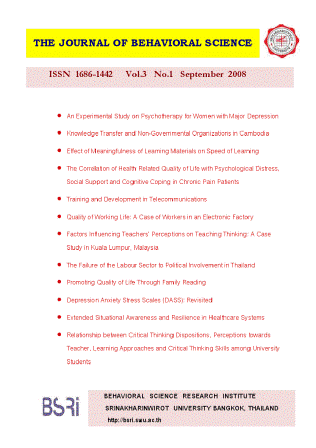Depression Anxiety Stress Scales (DASS): Revisited
Main Article Content
Abstract
To evaluate psychometric properties of DASS, data obtained from 850 university students (Men = 306, women = 533, 11 cases did not report their sex) were analyzed. For men average age was 22.13 (SD = 2.27) and for women the mean age was 21.63 (SD = 1.79). Coefficient alphas for Depression, Anxiety, Stress subscales and full Scale (DASS-42) were .88, .85, .86, and .95 respectively and for DASS-21 these values were .79, .70, .76, and .89. For the total sample correlations among DASS-42 subscales were .75 to .81 and among DASS-21 subscales correlations were .61 to .67. For women correlations among DASS-42 subscales were .73 to .80 and among DASS-21 subscales correlations were .59 t0 .65 and for men these correlations were .77 to .83 and .63 to .70 respectively. Corrected item-total correlations and the correlations between each item and DASS subscales were within acceptable boundaries. This was true for both DASS-42 and DASS-21. All the correlations were significant (p < .0001). Principal component analysis with varimax rotation did not result in simple factor structure for any of the three subscales. Very few items loaded only on their corresponding factors. Most items loaded on two factors. Some items loaded on three factors also. The overall results indicate that for assessing depression, anxiety, and stress of Malaysian population DASS is a reliable and valid instrument. However, locally translated and adapted version of DASS is likely to serve better. Discussion includes implications of these findings.
Keywords: depression, anxiety, stress, university students


